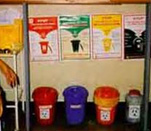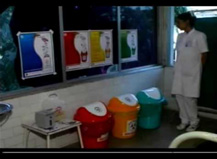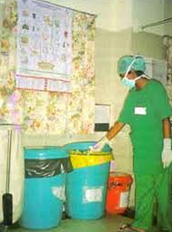WASTE MANAGEMENT
Hospital bio-medical waste management policy
Hospital bio-medical waste management policy is in compliance with Karnataka state pollution control board
In The Oxford Dental College, Biomedical waste is managed according to its type and characteristics. For waste management to be effective, the waste is managed at every step, from acquisition to disposal. The following are the elements of our comprehensive waste management system: waste survey, segregation, accumulation and storage, transportation, treatment, disposal and also waste minimization.
Waste survey
In the survey we differentiate and quantify the waste generated. To determine the points of generation, the type of waste at each point and the level of generation and disinfection within the dental hospital. This helps to determine the method of disposal.
 Waste segregation
Waste segregation
Waste segregation in our college consists of placing different kinds of wastes in different containers or coded bags at the point of generation. It helps to reduce the bulk of infectious waste as well as treatment costs. Segregation also helps to contain the spread of infection and reduces the chances of infecting other health care workers.
Waste accumulation and storage
Waste accumulation and storage occurs between the point of waste generation and site of waste treatment and disposal. While accumulation refers to the temporary holding of small quantities of waste near the point of generation, storage of waste is characterized by longer holding periods and large waste quantity.
Storage areas are posted with 'EXPLICIT' signs.

Waste transportation
The medical waste is transported from our college generation facility to another site through Maridi Eco industries private limited (GOVT of KARNATAKA) for treatment and disposal.
Waste treatment
Waste treatment is mainly required to disinfect or decontaminate the waste, right at source so that it is no longer the source of pathogenic organisms. After such treatment, the residue can be handled safely, transported and stored.
- Needles and syringe nozzle - shredded in needle destroyer and syringe cutters
- Scalpel blades/ Lancet/ Broken glass are put in separate containers with bleach, transferred to plastic/ cardboard boxes; sealed to prevent spillage and transported to incubators
- Glassware is disinfected, cleaned and sterilized
- Culture plates with viable culture should be autoclaved; media are placed in appropriate bags and disposed off. The plates are reused after sterilization
- Gloves are shredded / cut / mutilated before disposal.
 Swabs are chemically disinfected followed by incineration. If they contain only a small amount of blood that does not drip, they can be placed in the garbage.
Swabs are chemically disinfected followed by incineration. If they contain only a small amount of blood that does not drip, they can be placed in the garbage.- Disposable items are often recycled and have the risk of being used illegally. Dipping in freshly prepared 1% sodium hypochlorite for 30 min. - one hour, followed by mutilation before disposal should be the policy adopted for such items.
- Liquid waste generated by the laboratory is either pathological or chemical in nature. Non-infectious wastes are neutralized with reagents.
- Liquid infectious waste are treated with a chemical disinfectant for contamination and then neutralized.
Waste disposal
Waste disposal is through an organized facility provided by Maridi Eco Industries Pvt limited on everyday basis. Waste disposal during dental camps is through burial, and landfills.
Waste minimization
All measures are being undertaken to decrease the amount of infectious waste generated which will simultaneously decrease the cost of infectious waste disposal.

